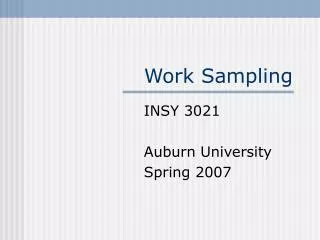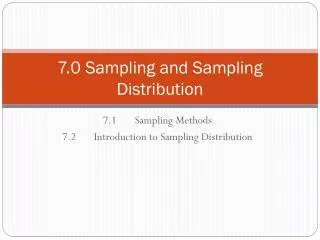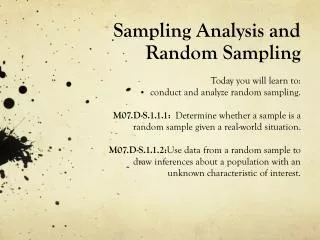WORK SAMPLING AND STRUCTURED ESTIMATING
WORK SAMPLING AND STRUCTURED ESTIMATING. CHAPTER 12. Work sampling is a method of finding the percentage occurrence of a certain activity by statistical sampling and random observations.
Share Presentation
Embed Code
Link
Download Presentation
- observations
- confidence level
- random observations
- work sampling
- random number table
- making sufficient random observations

vporter + Follow
Download Presentation
WORK SAMPLING AND STRUCTURED ESTIMATING
An Image/Link below is provided (as is) to download presentation Download Policy: Content on the Website is provided to you AS IS for your information and personal use and may not be sold / licensed / shared on other websites without getting consent from its author. Content is provided to you AS IS for your information and personal use only. Download presentation by click this link. While downloading, if for some reason you are not able to download a presentation, the publisher may have deleted the file from their server. During download, if you can't get a presentation, the file might be deleted by the publisher.
Presentation Transcript
- WORK SAMPLING AND STRUCTURED ESTIMATING CHAPTER 12
- Work sampling is a method of finding the percentage occurrence of a certain activity by statistical sampling and random observations. • Work sampling is the process of making sufficient random observations of an operator’s activities to determine the relative amount of time the operator spends on the various activities associated with the job. The major goal of work sampling is to determine how long, or how much of the work day, is spent on specific types of work. • Work sampling may identify the fact that certain operators spend a large portion of their time waiting for work, or performing paperwork tasks, or even performing activities that are not included in their job descriptions. • One of the basic foundations of statistical sampling theory is the concept that the larger the sample size, the results will be more accurate. • In work sampling, a sufficient number of observations must be made to be sure that the results accurately summarize the work performed. There are statistical formulas to help determine how many observations should be made.
- CONDUCTING A STUDY • It is recommended that a uniform procedure should be followed to perform a work sampling study is to 1. Establish the Purpose • First, the objective of the study should be established. Work sampling can be used to determine an overall perspective on the work done. 2. Identify the Subjects • Second, the people performing the task must be identified, i.e. general office work is being studied with the objective of determining overall productivity.
- 3. Identify the Measure of Output • The third step in making the study is the identification of the measure of the output produced or the types of activities performed on the jobs being studied. This step is especially important if the objective of the study is to measure productivity with the intent of setting a standard. 4. Establish a Time Period • Fourth, the time period during which the study will be conducted must be established. Starting and stopping points for the study must be defined as well. 5. Define the Activities • This step involves defining the activities that are performed by the people under study. For example, the definition used in a machine utilization study, including only the categories of working, idle, and idle-mechanical breakdown.
- 6. Determine the Number of Observations Needed • After the work elements are defined, the number of observations for the desired accuracy at the desired confidence level must be determined. If a reasonable guess cannot be made, then a trial study of perhaps 20 to 40 observations should be made to get an estimate. 7. Schedule the Observations • Once the number of required observations has been determined, either from appropriate statistical calculations or from tables, and the actual observations must be scheduled. Typically, the analyst will assign an equal number of observations each day during the course of the study. For example, if 800 observations are required and 20 work days are established as an appropriate observation time, 40 observations should be recorded each day. • A random number table can be used to establish the random times for each observation.
- 8. Inform the Personnel Involved • Before the study is actually performed, the personnel involved should be informed about the objective of the study and the methodology that will be employed. 9. Record the Raw Data • The next is the actual recording of the raw data. Although this recording can be performed by anyone, it is desirable that a trained analyst be employed. • It is also very important that the observations be made at exactly the same location every time. 10. Summarize the Data • After the data have been collected, they must be summarized.
- A few words about sampling • Sampling is mainly based on probability. Probability has been defined as “the degree to which an event is likely to occur”. • A simple and often-mentioned example that illustrates the point is that of tossing a coin. • The law of probability says that we are likely to have 50 heads and 50 tails in every 100 tosses of the coin. The greater the number of tosses, the more chance we have of arriving at a ratio of 50 heads to 50 tails. • The size of the sample is therefore important, and we can express our confidence in whether or not the sample is representative by using a certain confidence level. Establishing confidence levels • Let us go back to our previous example and toss five coins at a time, and then record the number of times we have heads and the number of times we have tails for each toss of these five coins. Let us then repeat this operation 100 times.
- To make things easier, it is more convenient to speak of a 95 per cent confidence level than of a 95.45 per cent confidence level. • To achieve this we can change our calculations and obtain: • 95 per cent confidence level or 95 per cent of the area under the curve = 1.96σp • 99 per cent confidence level or 99 per cent of the area under the curve = 2.58σp • 99.9 per cent confidence level or 99.9 per cent of the area under the curve = 3.3σp • In this case we can say that if we take a large sample at random we can be confident that in 95 per cent of the cases our observations will fall within ± 1.96 σp
- Determination of sample size • As well as defining the confidence level for our observations we have to decide on the margin of error that we can allow for these observations. • Let us look at our example about the productive time and the idle time of the machines in a factory. There are two methods of determining the sample size that would be appropriate for this example: • the statistical methodand the nomogram method. Statistical method. The formula used in this method is:
- Let us assume that some 100 observations were carried out as a preliminary study and at random, and that these showed the machine to be idle in 25 per cent of the cases (p = 25) and to be working 75 per cent of the time (q = 75). • We thus have approximate values for p and q; in order now to determine the value of n. • Let us choose a confidence level of 95 per cent with a 10 per cent margin of error (that is, we are confident that in 95 per cent of the cases our estimates will be ± 10 per cent of the real value).
- Nomogram methodAn easier way to determine sample size is to read off the number of observations needed directly from a nomogram such as the one reproduced in figure 91.
- Making random observations • To ensure that our observations are in fact made at random, we can use a random table such as the one in table 12. • Various types of random table exist, and these can be used in different ways. In our case let us assume that we shall carry out our observations during a day shift of eight hours, from 7 a.m. to 3 p.m. An eight-hour day has 480 minutes. These may be divided into 48 ten-minute periods. • We can start by choosing any number at random from our table, for example by closing our eyes and placing a pencil point somewhere on the table. Let us assume that in this case we pick, by simple chance, the number 11 which is in the second block, fourth column, fourth row (table 12). • We now choose any number between 1 and 10. Assume that we choose the number 2; we now go down the column picking out every second reading and noting it down, as shown below (if we had chosen the number 3, we should pick out every third figure, and so on). • 11 38 45 87 68 20 11 26 49 05
- Looking at these numbers, we find that we have to discard 87, 68 and 49 because they are too high (since we have only 48 ten-minute periods, any number above 48 has to be discarded). • Similarly, the second 11 will also have to be discarded since it is a number that has already been picked out. We therefore have to continue with our readings to replace the four numbers we have discarded. Using the same method, that is choosing every second number after the last one (05), we now have 14 15 47 22 • These four numbers are within the desired range and have not appeared before. Our final selection may now be arranged numerically and the times of observation throughout the eight-hour day worked out. Thus our smallest number (05) represents the fifth ten-minute period after the work began at 7 a.m. Thus our first observation will be at 7.50 a.m., and so on (table 13).
- Example: Conducting the study • Determining the scope of the study. Before making our actual observations, it is important that we decide on the objective of our work sampling. • The simplest objective is that of determining whether a given machine is idle or working. In such a case, our observations aim at detecting one of two possibilities only: • We can, however, extend this simple model to try to find out the cause of the stoppage of the machine:
- Making the observations • So far we have taken the first five logical steps in conducting a work sampling study. • selecting the job to be studied and determining the objectives of the study; • making a preliminary observation to determine the approximate values of p (idle) and q (working); • in terms of a chosen confidence level and accuracy range, determining n (the number of observations needed) determining the frequency of observations, using random tables; • designing record sheets to meet the objectives of the study. • There is one more step to take: that of making and recording the observations and analyzing the results.
- Work Sampling Observation Form
- Advantages of Work Sampling • Can be used to measure activities that are impractical to measure by direct observation • Multiple subjects can be included • Requires less time and lower cost than continuous direct observation • Training requirements less than DTS or PMTS • Less tiresome and monotonous on observer than continuous observation • Being a subject in work sampling is less demanding than being watched continuously for a long time
- Disadvantages and Limitations • Not as accurate for setting time standards as other work measurement techniques • Usually not practical to study a single subject • Work sampling provides less detailed information about work elements than DTS or PMTS • Since work sampling deals with multiple subjects, individual differences will be missed • Workers may be suspicious because they do not understand the statistical basis of work sampling

WORK SAMPLING AND STRUCTURED ESTIMATING
WORK SAMPLING AND STRUCTURED ESTIMATING. CHAPTER 12. Work sampling is a method of finding the percentage occurrence of a certain activity by statistical sampling and random observations.
1.64k views • 21 slides

Work Sampling
Work Sampling. INSY 3021 Auburn University Spring 2007. Work Sampling. A technique that discovers the proportions of total time that various activities contribute to the job by taking a relatively large # of observations at random intervals
791 views • 24 slides

Sampling Methods and Sampling Distributions
Sampling Methods and Sampling Distributions. Chapter . GOALS. EXPLAIN WHY SAMPLES ARE USED. DEFINE AND CONSTRUCT A SAMPLING DISTRIBUTION OF SAMPLE MEANS. EXPLAIN THE CENTRAL LIMIT THEOREM CALCULATE CONFIDENCE INTERVALS FOR MEANS AND PROPORTIONS.
772 views • 35 slides

Sampling and Sampling Distributions
Sampling and Sampling Distributions. Aims of Sampling Probability Distributions Sampling Distributions The Central Limit Theorem Types of Samples. Aims of sampling. Reduces cost of research (e.g. political polls)
1.04k views • 33 slides

Chapter 14: Work Sampling
Work Sampling. Provides a different way to observe processes than time studies,Advantage: You don't have to observe all the time, just some of the time.Examples of Methods:Analyst makes observations of processes at random times.Worker (or subject) wears a timer that goes off at random times. Ma
301 views • 19 slides

STRUCTURED WORK SYSTEMS
STRUCTURED WORK SYSTEMS. PRESENTED BY DIANE BROWN JULY 2014 HIGH PLAINS EDUCATIONAL COOPERATIVE. S. Small Group -teach social skills, games and turn taking, appropriate play and communication exchange.
697 views • 49 slides

7.0 Sampling and Sampling Distribution
7.0 Sampling and Sampling Distribution. 7.1 Sampling Methods 7.2 Introduction to Sampling Distribution. Types of Samples. Convenience Sampling. Selection of elements is left primarily to the interviewer. Easy, inexpensive, or convenient to the sample
1.37k views • 36 slides

HL7 Clinical Genomics and Structured Documents Work Groups
HL7 Clinical Genomics and Structured Documents Work Groups. CDA Implementation Guide: Genetic Testing Report DRAFT PROPOSAL Amnon Shabo (Shvo), PhD shabo@il.ibm.com HL7 Clinical Genomics WG Co-chair and Modeling Facilitator HL7 Structured Documents WG CDA R2 Co-editor
245 views • 13 slides

SAMPLING AND SAMPLING DISTRIBUTIONS
SAMPLING AND SAMPLING DISTRIBUTIONS. CONTENTS. STATISTICS IN PRACTICE:MEAD CORPORATION 7.1 THE ELECTRONICS ASSOCIATES SAMPLING PROBLEM 7.2 SIMPLE RANDOM SAMPLING Sampling from a Finite Population Sampling from an Infinite Population 7.3 POINT ESTIMATION
1.34k views • 36 slides

Estimating and Costing
Estimating and Costing. Rick Dewar (and Brian Palmer). Aims of Topic. The group project did not have to take account of real costs, and estimates were probably “guestimates”. This topic will address those missing components estimating how long things will take
868 views • 55 slides

Work Sampling
Work Sampling. INSY 3021 Auburn University Spring 2008. Work Sampling. A technique that discovers the proportions of total time that various activities contribute to the job by taking a relatively large # of observations at random intervals
1.95k views • 24 slides

Sampling and Sampling Distributions
Sampling and Sampling Distributions. 2013/12/02. Sampling methods. Random sampling : Choose the elements for the sample one at a time in such a way that, at each step, each of the events remaining in the population has the same probability of being selected.
429 views • 8 slides

Estimating and Computations
Estimating and Computations. Different Types Of Estimation. Rounding to a Place Value Front End Estimation Round to Greatest Place Round to Lesser Place Estimating with Compatible Numbers. Rounding to a Place Value. We learned last week. Example round to the nearest tenth 45. 7 9
313 views • 10 slides

Rounding and Estimating
Rounding and Estimating. PRE-ALGEBRA LESSON 3-1. Round each number to the underlined place value. a. 89.63. c. 0.83476. b. 579,122. 90. 600,000. 0.8348. 3-1. Rounding and Estimating. PRE-ALGEBRA LESSON 3-1. (For help, go to Skills Handbook page 727.).
1k views • 68 slides

Sampling Methods and Sampling Distributions
Sampling Methods and Sampling Distributions. Chapter. GOALS. EXPLAIN WHY SAMPLES ARE USED. DEFINE AND CONSTRUCT A SAMPLING DISTRIBUTION OF SAMPLE MEANS. EXPLAIN THE CENTRAL LIMIT THEOREM CALCULATE CONFIDENCE INTERVALS FOR MEANS AND PROPORTIONS.
580 views • 35 slides

Sampling Analysis and Random Sampling
Sampling Analysis and Random Sampling. Today you will learn to: conduct and analyze random sampling. M07.D-S. 1.1.1: Determine whether a sample is a random sample given a real-world situation .
236 views • 4 slides

Structured Importance Sampling of Environment Maps
Structured Importance Sampling of Environment Maps. Agarwal, S., R. Ramamoorthi, S. Belongie, and H. W. Jensen. Outline. Monte Carlo Sampling and Importance metric Variance Analysis for Visibility Hierarchical Environment Map Stratification Rendering Optimizations.
414 views • 25 slides

Sampling and Sampling Distributions
Sampling and Sampling Distributions. A statistical population is the aggregate of all the units pertaining to a study. i.e. it is the set of all elements about which we wish to make inferences. A sample is a subset of a population.
509 views • 32 slides

Sampling and Sampling Distributions
Sampling and Sampling Distributions. Simple Random Sampling Point Estimation Sampling Distribution. Statistical Inference. The purpose of statistical inference is to obtain information about a population from information contained in a sample.
457 views • 41 slides

Sampling and Sampling Distribution
Welcome To A Session on. Sampling and Sampling Distribution. What are various approaches to sample size determination?. There are two alternative approaches for determining the size of the sample.
569 views • 38 slides

PLANNING AND ESTIMATING
PLANNING AND ESTIMATING. Planning and Estimating. Before starting to build software, it is essential to plan the entire development effort in detail Planning continues during development and then postdelivery maintenance Initial planning is not enough
745 views • 73 slides

Sampling and Sampling Distributions
Sampling and Sampling Distributions. Aims of Sampling Probability Distributions Sampling Distributions The Central Limit Theorem Types of Samples. Aims of sampling. Reduces cost of research (e.g. political polls)
421 views • 35 slides
























